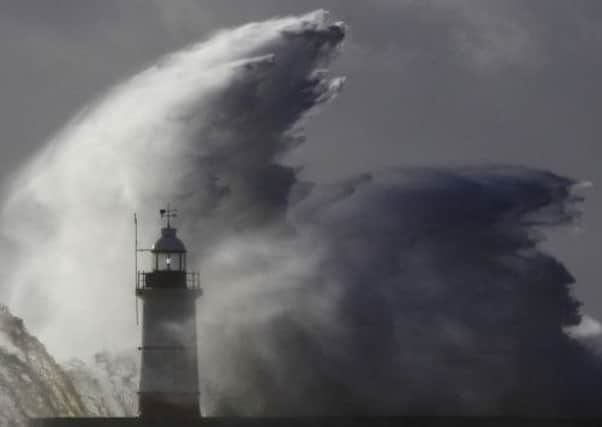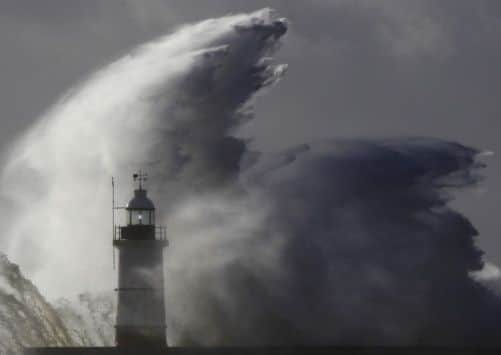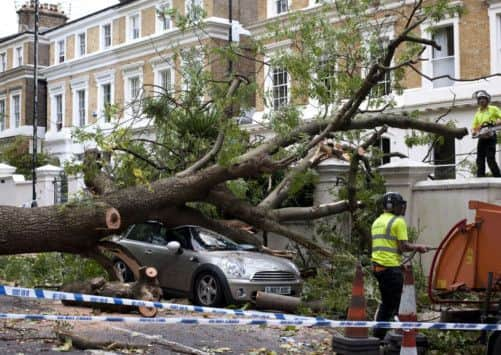Weather: Four dead and 600,000 without power


Bethany Freeman, 17, suffered fatal injuries in Hever, Kent, when a 30ft tree landed on her static caravan, while in Watford, Donal Dohan, 51, was killed after a tree fell on to his car.
The bodies of a man in his forties and a woman were recovered from a severely damaged property in Hounslow, west London, after a suspected gas explosion caused by a felled tree.
Advertisement
Hide AdAdvertisement
Hide AdMore than 600,000 homes suffered power cuts as winds of up to 100mph swept through parts of England after hitting the mainland in the early hours of Monday morning.


The storm’s trail of destruction also brought misery for tens of thousands of commuters, with delays and cancellations on a crippled rail network, the closure of the port of Dover and the cancellation of more than 130 flights from Heathrow.
Debris falling on to power lines caused the Dungeness B nuclear power station in Kent to automatically close down both reactors, leaving its own diesel generators to provide power for essential safety systems.
Tributes were paid to the casualties of the storm. In Hever, people mourned the death of Ms Freeman, a gifted grammar school girl with “everything to look forward to”. The teenager, nicknamed Gia, was killed shortly after 7:15am, when one of the mobile homes she and her family were staying in temporarily was crushed by a tree.
Neighbours told how people used chainsaws to try to help free the trapped youngster, but she was pronounced dead by paramedics. Her driving instructor, Neil Chapman, turned up outside her home unaware she had been killed. A visibly shocked Mr Chapman said: “I can’t believe it. She was a super kid. She was a great girl, good fun. I can’t believe it.”


Mr Drohan, a father of three from Harrow, was struck by a tree shortly before 7am while driving in his Peugot 307. A
police officer at the scene said a millisecond’s difference in his journey would have made for “a different story”.
In a statement, Mr Drohan’s family said: “He was the best husband and father anyone could wish for. You couldn’t find anyone who had a bad word to say about him.”
Advertisement
Hide AdAdvertisement
Hide AdIn Hounslow, the two victims were trapped in one of three properties damaged by an explosion, thought to have been caused by a ruptured gas main. Emergency services took three people to hospital, including a woman with burn injuries to her hand.
In Newhaven, west Sussex, police and the RNLI were continuing the search for a schoolboy swept out to sea on Sunday afternoon. Dylan Alkins, 14, had been swimming with friends when police said the current dragged him away from the group.
Prime Minister David Cameron said the loss of life was “hugely regrettable” and that the government was working to make sure the emergency services were able to do as much as possible. He said: “We have to make sure the emergency services can act as fast as they can to help people.”
At its peak, the mid-latitude storm, known as St Jude, heralded gusts as high as 99mph on the Isle of Wight at about 5am. However, by Monday afternoon the Met Office lifted its amber warning as the heart of the storm passed over Norfolk and into the North Sea.
The Energy Networks Association, which represents power companies across the UK, said about 407,000 households that had lost power during the storm had been reconnected, although a further 200,500 homes were still without power on Monday night.
Network Rail described damage to railway lines as “worse than expected”, with more than 100 fallen trees on the lines.
Train services were completely cancelled across large parts of England for part of the day, with companies including South West Trains, Southern and Southeastern running reduced timetables in the evening. East Coast services did not operate between London King’s Cross and Peterborough. On the roads, fallen trees and overturned lorries caused widespread problems, with major arteries such as the M2 and M11 badly hit.
The Environment Agency had dozens of flood warnings in place across swathes of south-west England, East Anglia and the Midlands, but as of early Monday evening, had reduced that number to just four, although there remained up to 100 flood alerts throughout England and Wales following the heavy rain.
Advertisement
Hide AdAdvertisement
Hide AdAs the storm moved away from Britain, casualties were reported elsewhere in Europe.
Amsterdam police said a woman was killed by a falling tree, while German authorities said two people were killed when a tree fell on their car in Gelsenkirchen.
Experts said that while the gales had been relatively weak compared with the Great Storm of 1987, it had shown how much weather predictions had improved compared with 26 years ago, when forecaster Michael Fish famously got it wrong when he told viewers that a hurricane was not on its way – just hours before the storm ripped through Britain.
Sean Penston at MeteoGroup said: “This time around the event was quite well forecast, especially when you bear in mind that it wasn’t even a physical entity when it was predicted.
“The forecasting models did really well in terms of mapping the storm, due to great improvements in computer power and our understanding of the physics of the atmosphere.”
Laura Young: Balmier south unprepared for winds more common in north
The mid-latitude storm has been described as a hurricane, but we don’t get hurricanes in the UK at all. A hurricane is a tropical storm and it would only happen in sea conditions of 26C. A particularly powerful storm would require a minimum sea surface temperature of about 28C, something which you are never ever going to see off the coast of the UK.
You will see mid-latitude storms on the north coast of Scotland two or three times a year, with wind speeds of 80mph to 90mph. However, that is a relatively uninhabited area, and people are more prepared for such weather because it’s more of a regular occurrence.
Advertisement
Hide AdAdvertisement
Hide AdWith this storm, it’s happening in built-up areas in the south coast, where trees are in leaf and the ground is quite wet – there has been more of a potential for a severe impact.
It’s not unusual for us to come into periods of unsettled or stormy weather at this time of the year.
Autumns have been relatively settled for the past couple of years, and people do forget that we can get unsettled weather at this time. The storm isn’t unusual, but it just happens to be a significant weather event.
Although it’s still windy, a lot of the conditions will ease on Tuesday in the area that’s been affected, so hopefully we’ll see a period of more settled weather for the next couple of days at least.
In Scotland, some light rain is forecast in the north and south-west overnight. On Tuesday there will be a fair bit of rain in most of the west coast and the far north-west, but throughout the day there will clearer, brighter spells, particularly around Edinburgh and the east coast.
On Wednesday, things will start off dry, with rain later – although the rain will be interspersed with sunny spells.
• Laura Young is a forecaster with the Met Office